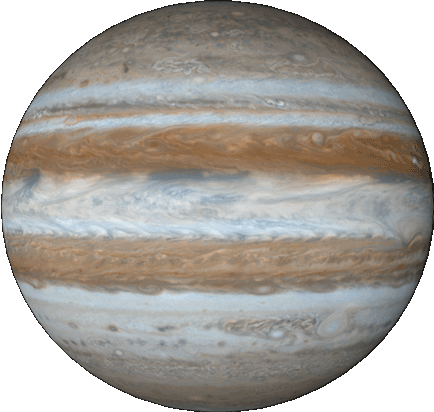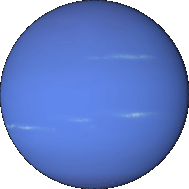Jupiter and OUR
SOLAR SYSTEM
For example, Jupiter is the reason why there’s an asteroid belt – and not another planet – between it and Mars. Jupiter has also catapulted countless comets out to the edge of the solar system. Like a gatekeeper, Jupiter has safeguarded Earth from many comet impacts
The planets are the leftovers from the star-forming process, and Jupiter accounts for the bulk of that material – more – more than twice that of all the other planets combined. Its atmosphere – predominantly hydrogen and helium – is similar to the composition of the sun and other stars as well as the clouds of gas and dust in our galaxy.
When the sun was born – when it accumulated enough mass for nuclear fusion to ignite – it generated a wind that blew away most of the gas and dust that still remained. The fact that Jupiter’s composition is similar to that of the original cloud suggests that it formed early on, before the wind could clear away that material.
To give you an idea of how dominant Jupiter is, an alien observing our solar system through a telescope would see an average yellow star and Jupiter with three other large planets. Earth and the inner planets would appear merely as debris.
Explore
Interact with the planets below to learn more.
-
 mercury
mercury
Mercury
Orbiting so close to the sun, Mercury is constantly hammered by heat and solar wind.
DISTANCE FROM THE SUN57,910,000 kilometers (35,983,606 miles)DIAMETER4,879 kilometers (3,032 miles)MOONSNoneAVERAGE SURFACE TEMPERATURE167 degrees Celsius (333° Fahrenheit) 333-452°C (603-846 °F) on the sunward sideROTATION PERIOD TIME (length of day)4222.6 hours (about 176 Earth days)ORBITAL PERIOD88 daysCOMPOSITIONRock, MetalATMOSPHEREEssentially a vacuum: Oxygen (O2) 42%,Sodium (Na) 29%, Hydrogen (H2) 22%, Helium (He) 6%, Other gases: Trace amountsPLANETARY RING SYSTEMNo
-
 venus
venus
Venus
Venus suffered an enormous change sometime in its past which evaporated its water and spewed huge amounts of carbon dioxide into its atmosphere, forever changing the planet.
DISTANCE FROM THE SUN108,210,000 kilometers (67,238,577 miles)DIAMETER12,104 kilometers (7521 miles)MOONSNoneAVERAGE SURFACE TEMPERATURE464° Celsius (867° Fahrenheit)ROTATION PERIOD TIME (length of day)2802 hours (about 117 Earth days)ORBITAL PERIOD255 daysCOMPOSITIONRock & MetalATMOSPHERECarbon Dioxide (CO2) 96.5%, Nitrogen (N2) 3.5%, Other gases: Trace amountsPLANETARY RING SYSTEMNo
-
 earth
earth
Earth
The only planet we know to harbor life, Earth is covered with liquid water. But the planet we know today is nothing like it was when it first formed.
DISTANCE FROM THE SUN149,600,000 kilometers (92,957,130 miles)DIAMETER12,756 kilometers (7926 miles)MOONS1AVERAGE SURFACE TEMPERATURE15º Celsius (59º Fahrenheit)ROTATION PERIOD TIME (length of day)24 hours (1 Earth day)ORBITAL PERIOD365 days (1 Earth year)COMPOSITIONRock & MetalATMOSPHERENitrogen (N2) 78%, Oxygen (O2) 21%, Argon (Ar) 0.9%, Water (H20) 0.4 (Variable), Carbon Dioxide (CO2) 0.04%, Other gases: Trace amountsPLANETARY RING SYSTEMNo
-
 mars
mars
Mars
The Red Planet once had an active core like Earth’s, an internal heat engine that generated a magnetic field. But it shut down long ago as the planet cooled, allowing the solar wind to strip away its now vulnerable atmosphere.
DISTANCE FROM THE SUN227,920,000 kilometers (141,622,922 miles)DIAMETER6,792 kilometers (4,220 miles)MOONS2AVERAGE SURFACE TEMPERATURE-63º Celsius (-81º Fahrenheit)ROTATION PERIOD TIME (length of day)24.7 hoursORBITAL PERIOD686 days (1.8 Earth years)COMPOSITIONRock & MetalATMOSPHERECarbon Dioxide (CO2) 95.32%, Nitrogen (N2) 2.7%, Argon (Ar) 1.6%; Oxygen (O2) 0.13%; Carbon Monoxide (CO) 0.08%, Other gases: Trace amountsPLANETARY RING SYSTEMNo
-
 jupiterjupiter
jupiterjupiterProbably the first planet to form, Jupiter holds clues about the origin of the solar system.
Jupiter
Because Jupiter was probably the first planet to form, its composition and internal structure are the keys to learning what the solar system was like more than 4.5 billion years ago.
DISTANCE FROM THE SUN778,570,000 kilometers (483,780,969 miles)DIAMETER142,984 kilometers (88,846 miles)MOONSAt least 63AVERAGE SURFACE TEMPERATURE-108º Celsius (-162º Fahrenheit) at altitude where pressure is Earth normal (1 bar)ROTATION PERIOD TIME (length of day)9.9 hoursORBITAL PERIOD11.9 Earth yearsCOMPOSITIONMostly light gases, some heavier materialsATMOSPHEREHydrogen (H2) 86%, Helium (He) 13.6%, Methane (CH4) 0.2%, Ammonia (NH3) 0.06%, Hydrogen Sulfide (H2S) 0.01%, Water At least 0.04%, Other gases: Trace amountsPLANETARY RING SYSTEMYes
-
 saturn
saturn
Saturn
Famous for its magnificent rings, Saturn is made out of the same materials as Jupiter. But the proportions are different and Saturn is three times less massive. Even though Saturn is just the next planet after Jupiter, it’s twice as far from the Sun.
DISTANCE FROM THE SUN1,433,530,000 kilometers (890,754,245 miles)DIAMETER120,536 kilometers (74,898 miles)MOONSAt least 62AVERAGE SURFACE TEMPERATURE-139º Celsius (-218º Fahrenheit) at altitude where pressure is Earth normal (1 bar)ROTATION PERIOD TIME (length of day)10.6 hoursORBITAL PERIOD29.4 Earth yearsCOMPOSITIONMostly light gases, some heavier materialsATMOSPHEREHydrogen (H2) 96.3% (2.4%), Helium (He) 3.25% (2.4%), Other gases: Trace amountsPLANETARY RING SYSTEMYes
-
 uranusuranus
uranusuranusUranus’s axis is tilted to almost 90 degrees, giving it the most extreme seasons in the solar system.
Uranus
With an axis tilted almost 90 degrees to the Sun, Uranus has the most extreme seasons in the solar system.
DISTANCE FROM THE SUN2,870,972,200 kilometers (1,783,935,996 miles)DIAMETER50,724 kilometers (31,518 miles)MOONSAt least 27AVERAGE SURFACE TEMPERATURE-197° Celsius (-323° Fahrenheit) at altitude where pressure is Earth normal (1 bar)ROTATION PERIOD TIME (length of day)17.24 hoursORBITAL PERIOD84 Earth yearsCOMPOSITIONMostly light gases, some heavier materialsATMOSPHEREMolecular hydrogen (H2) 82.5%, Helium (He) 15.2%, Methane (CH4) 2.3%, Other gases: Trace amountsPLANETARY RING SYSTEMYes
-
 neptuneneptune
neptuneneptuneNeptune’s winds are among the fiercest in the solar system, blowing at over 1,000 miles per hour.
Neptune
Neptune has some of the fiercest winds in the solar system, with gusts blowing at more than 1,000 miles per hour.
DISTANCE FROM THE SUN4,498,252,900 kilometers (2,795,084,800 miles)DIAMETER49,248 kilometers (30,775 miles)MOONSAt least 13AVERAGE SURFACE TEMPERATURE-201° Celsius (-330° Fahrenheit) at altitude where pressure is Earth normal (1 bar)ROTATION PERIOD TIME (length of day)16.1 hoursORBITAL PERIOD164.79 Earth yearsCOMPOSITIONMostly light gases, some heavier materialsATMOSPHEREMolecular hydrogen (H2) 80.0%, Helium (He) 19.0%, Methane (CH4) 1.5%, Other gases: Trace amountsPLANETARY RING SYSTEMYes
